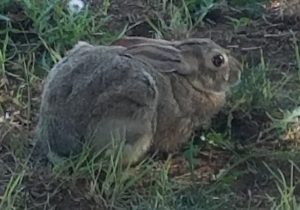Early morning is my favorite time of day in the desert. You can smell the sagebrush and rabbitbrush, the tiniest hint of moisture, and absorb the quiet and stillness.

We live in a house with an established yard and big shade trees, but it’s still in the desert. I love to look out the window or sit on the porch as I sip my coffee and watch the wildlife come into the yard. Squirrels, sparrows, orioles, cardinals and rabbits. Lots and lots of rabbits this year. But the lizards are scarce, for some reason. Maybe the road runner that was hanging around in February and March thinned them out.
The other morning, I was surprised to see two house finches trying to eat out of a hummingbird feeder. And one of the hummingbirds was letting them know he wasn’t pleased, darting around and chittering at them. I grabbed some slippers and ran out to put water in the dog’s bowls. I swear, the critters use them more than she does.
They all gravitate to our yard because of the drought. And heat. Summer started in March this year, and we’ve been averaging 15 degrees above normal. July temps in May, and August temps in June. It’s hard on the people, the animals and the plants. One peach tree is dying. Too hot, too soon. The other, a different variety, is doing fine except that the fruit is so small. And my roses have been hit hard. The hot wind dries them out, but the mineral-heavy water doesn’t always help. Hard to believe you can overwater in the desert, but it’s true.
I admire the master gardener down the road who has a wonderful yard made for the arid climate. Lots of native plants, succulents and such. Yet I notice she has her big shade trees by the house. Shade is priceless, and folks will put up with bores and beetles and bird droppings and whatever to have a shade tree. My husband loves his grass, and I like the coolness it gives (but not the pollen — allergies, you know). However, the best part is watching the critters and the cycle of life.
The sparrows and doves don’t limit themselves to one breeding cycle here. Especially after a windstorm, it’s common to find a fledgling or two bouncing through the grass and crying for mama. Grackles will try to steal dove nests, and the doves and sparrows will team up against the grackles. Until a hawk or owl drops by, then everyone turns silent. Still, the heat takes its toll. Whenever it gets above 100, I can count on finding at least one bird in the yard that didn’t make it.

Even the dog ignores the carcasses now. However, she loves to chase the squirrels, and they love to tease her! The game is to either run around a tree trunk barely above her head or sit on a branch and scold her while she tries to jump at them.
I used to see a fox now and then, and frequently coyotes. The foxes may have been trapped or run off when the neighbor cleared his pasture. And the coyotes are probably just waiting until their kits are a little older, or the rabbits are cleared out of their mesquite haven where pumpjacks squeak and cattle wander in the section south of us. Lots of rabbits always lead to lots of coyotes. Just a matter of time. Until the drought and heat take their toll, the balance tilts the other way, and the cycle begins again.
And when the rains finally come? The people will grumble and curse at the flooded roads, comparing who got more rain or had to detour because of the spinouts and wrecks. But the desert – the desert will drink it in and relish in being cleansed of the pervasive dust. Wildflowers will burst into bloom. The birds will flock to the ground for ants escaping from the wet. And the smell of fresh, clean desert will hang in the air briefly, renewing and regenerating anyone willing to partake before the sun dries it all and the dust blows again.